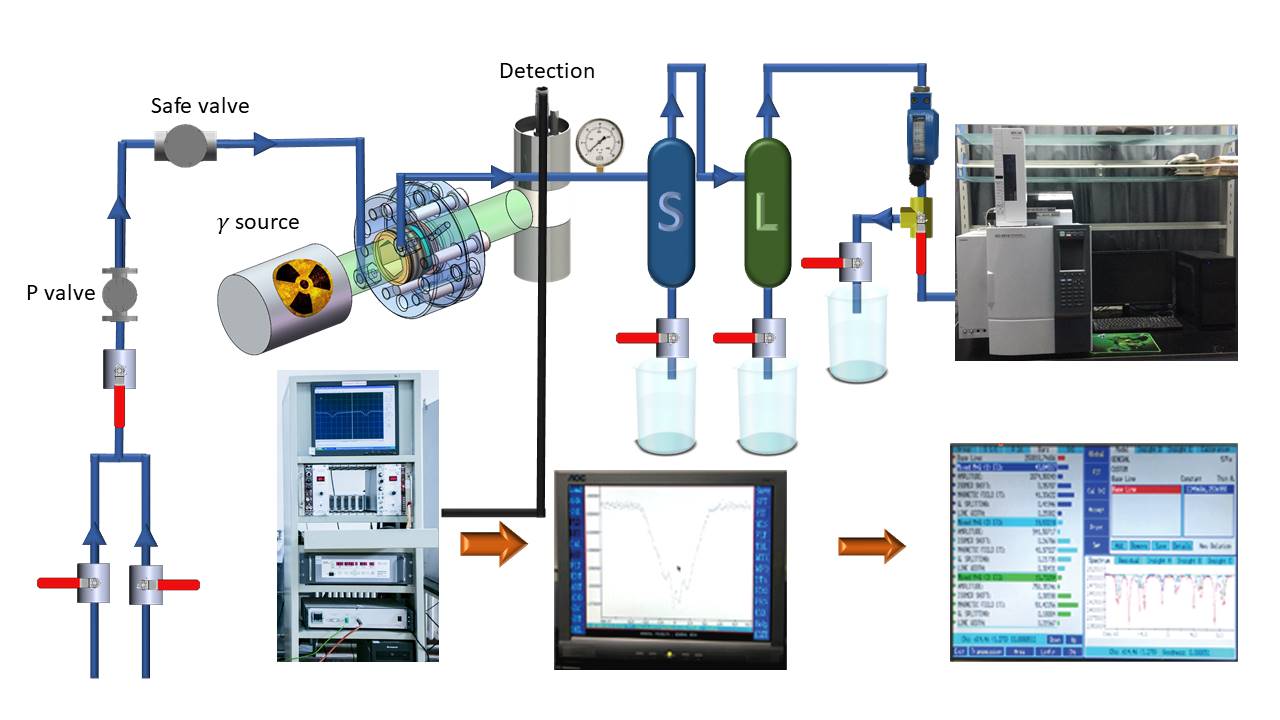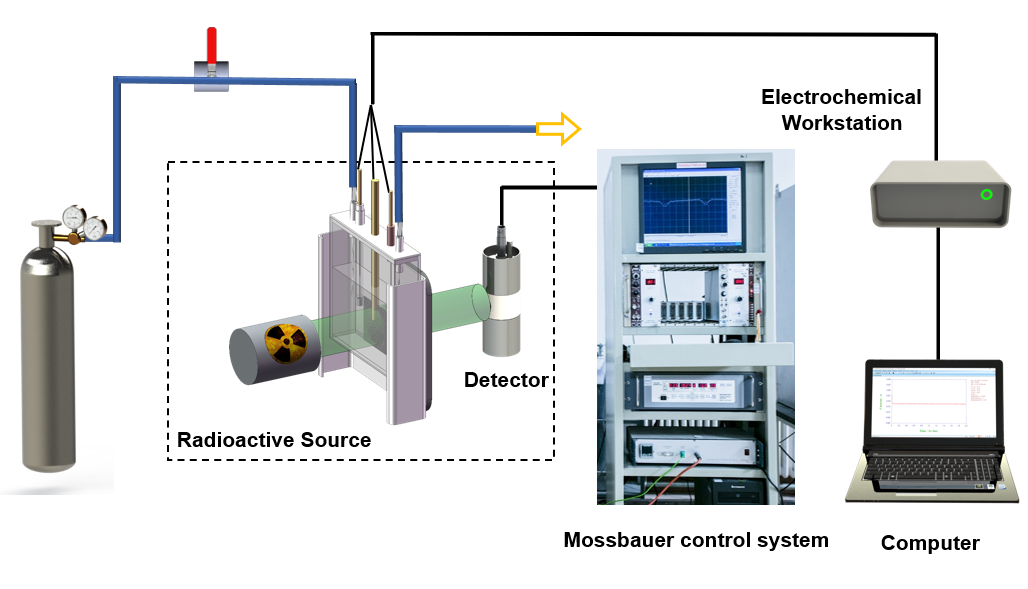1. Genernal Introduction
Center for Advanced Mössbauer Spectroscopy has several sets of advanced 57Fe and 119Sn Mössbauer spectrometers, which can dynamically track the state changes of Mössbauer nuclides in functional materials under various in-situ/operando conditions.
The low temperature Mössbauer measurements use Janis continuous flow cryostat system, which can realize variable temperature observation from 4.2K to room temperature and even above.
Equipped with 57Fe and 119Sn internal conversion electron Mössbauer spectra (CEMS) detectors, the surface properties of functional materials can be studied with selected surface thickness.
Management and operation of the Mössbauer Effect Data Center (MEDC), which is responsible for the publication of Mössbauer Effect Reference and Data Journal (MERDJ) and the development and maintenance of the world's largest MEDC database. The MERDJ and Database of the MEDC are online open world wide, which can directly provide information support for the fitting and analysis ofthe measured Mössbauer spectra.
Our services include not only Mössbauer spectral measurements, but also professional Mössbauer spectral fitting and analytical results discussion. We aim to provide worldwide first-class Mössbauer spectral application research resources to the users around the world. Through extensive international and domestic cooperation and exchanges, cultivate more young scholars engaged in the applications of the Mössbauer spectral studies.
2. Features of Mössbauer Spectrometer
1) Ultra low vibration (standard iron foil's spectral line width is less than 0.28mm/s)
2) Ultra high energy resolution (10-8eV)
3) Big various temperature range: room temperature, low temperature (4.2 - 300K) and high temperature (300 - 1273K)
4) Transmission and internal conversion electron double modes
5) In-situ/operando characterizations (various redox atmospheres, temperature, pressure, light irradiation, thermal catalysis, photocatalysis, electrocatalysis, battery, external magnetic field, etc.)
6) Professional Mössbauer spectral fitting software
7) Multiple radiation safety protection
3. Application Fields
Mössbauer spectroscopy is to study the electron behavior outside the nucleus by observing the resonance absorption phenomenon of the nucleus to gamma rays. It has been widely used in many research fields such as material structure, chemical bond, magnetism, in-situ state analysis and so on. The hyperfine structure of Mössbauer spectra is very sensitive to chemical, structural and magnetic changes of Mössbauer nuclides. In addition to solid samples, liquid samples can also be measured by rapid freezing. In the study of heterogeneous catalysis, the structure-activity relationship between active phase and catalytic properties and its catalytic mechanism, the possible activation or inactivation process of the catalyst in the catalytic reaction, and the chemical adsorption behavior of the reactants or molecular probes can be directly discussed by means of Mössbauer characterization.
Examples of our services:
1) Room temperature transmission 57Fe and 119Sn Mössbauer spectral characterizations
2) Room temperature 57Fe and 119Sn CEMS characterizations
3) Low temperature and variable temperature 57Fe and 119Sn Mössbauer spectral characterizations
4) High temperature and variable temperature 57Fe and 119Sn Mössbauer spectral characterizations
5) High temperature, high pressure and atmospherecontrol in-situ/operando 57Fe and 119Sn Mössbauer spectral characterizations to various ironor tin-based catalysts such as Fischer-tropsch synthesis, carbon dioxide hydrogenation, ammonia synthesis and decomposition under working conditions
6) Electrochemical in-situ/operando 57Fe and 119Sn Mössbauer spectral characterizations to various ironor tin-based catalysts such as electrolysis water for hydrogen production, electrocatalytic reduction of carbon dioxide under workingc onditions
7) Photocatalytic in-situ/operando 57Fe and 119Sn Mössbauer spectral characterization
8) Vacuum frozen solution variable temperature 57Fe and 119Sn Mössbauer spectral characterizations
9) Unstable samples 57Fe and 119Sn Mössbauer spectral characterizations (sample preparation in glove box atmosphere protection, in-situ/operando atmosphere control characterization, etc.
10) Low temperature 57Fe and 119Sn Mössbauer spectral characterizations with external magnetic field (completed with international collaborators)
11) 151Eu, 121Sb, 197Au Mössbauer spectral characterizations (completed with international collaborators)

Fig. 1 schematic diagram of in-situ/operando thermocatalytic Mössbauer spectral characterization instrument

Fig. 2 schematic diagram of in-situ/operando Mössbauer spectral characterization instrument for high temperature, high pressure and atmosphere control catalytic reactions

Fig. 3 schematic diagram of in-situ/operando electrocatalytic Mössbauer spectral characterization instrument
4. Reservation Method
Before making reservation, please first contact
Email: mossbauer@dicp.ac.cn, Tel: +86-411-84379711
5. Sample Requirements
In principle, the sample should be solid powder, and the recommended absorption thickness of iron/tin in the sample is about 10mg/cm2. The sample amount can be calculated according to the formula of 10mg/cm2 dividing by the percentage of iron/tin in the sample.
In principle, all kinds of samples containing Mössbauer nuclides, mainly iron and tin, can be characterized by Mössbauer spectroscopy. Solid samples with very low iron content, as well as frozen solution samples, often require the use of enriched isotopes, such as the precursor of 57Fe, to prepare samples. We can provide 57Fe enriched isotopes in metallic state to the customers so as to shorten the testing time and improve the signal-to-noise ratio of spectra.
6. Contacts
Dr. Rge
Tel: +86-411-84379711
Email: mossbauer@dicp.ac.cn
Mobile phone: +86-18624280695(Wechat)
7. Others
In addition to the above advanced Mössbauer spectral characterizations, we also have a variety of instruments and devices for the synthesis and characterization of thermocatalysis, photocatalysis and electrocatalysis materials.